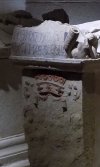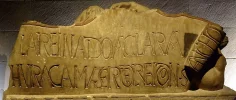You always find such intriguing historical questions
@Bert45 !
I am ignorant to the history but appreciate trying to learn more. I wonder if "clara" was an adjective, not her proper name. She had also been the wife of two previous kings (of Leon) who died, so maybe her name was disambiguated to be "clearly" the queen of Sancho II?

en.wikipedia.org
Here is a source for you to dig into; if you do a search for "clara" you will find references to Queen Urraca, wife of King Sancho II, which are copied below.
a) Titulatio:
"Ego humilis et seruus seruorum omnium Domini ultimus et tamen gratia Dei,
Sanctius rex et Ranemirus rex, seu
cum clara Urraka regina (...)"
("yo, humilde y último siervo de todos los siervos del Señor, y sin embargo, por la
gracia de Dios, Sancho el rey, y también el rey Ramiro, y asimismo con la clara
reina Urraca,...")
Subscriptio:
"(...) regnante (...) Sanctione rex in Nagela et in Pampilona, et sub eius imperio
parendo rex Ranemirus in Uekaria (...) Sanctius serenissimus rex, cum prolis
Garseani, hunc testamentum manu propia confirmans (signum); Ranemirus
frater ipsius regis confirmans; domna Urraka clara regina confirmans (...)"
("reinante...Sancho rey en Nájera y en Pamplona, y bajo la dependencia del
imperio de éste el rey Ramiro en Viguera...Sancho, rey serenísimo, con su hijo
García, confirmando este testamento con su propia mano; Ramiro, hermano de ese
rey, confirmándolo;
doña Urraca, clara reina, confirmándolo..."

























